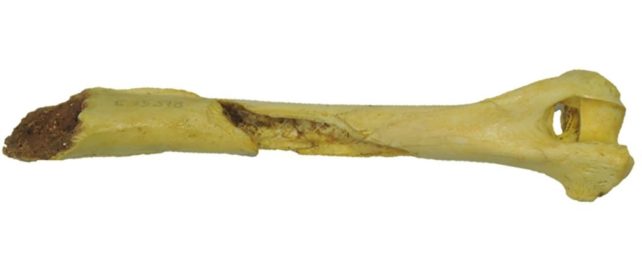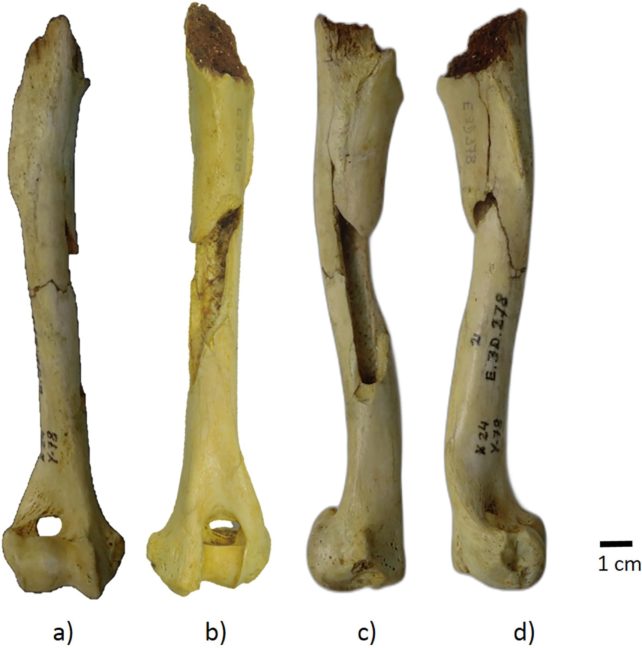An ancient bone is helping scientists refine the timeline of humanity's relationship with our best friends – the canine companions that have brightened our lives for millennia.
How many millennia? Well, no one knows for sure. But precision carbon dating is helping narrow it down.
A canine humerus recovered from Erralla cave in the Basque Country, Spain in 1985 has now been dated to between 17,410 and 17,096 years ago. And multiple lines of analysis confirm it's not from a wolf, but a dog: Canis familiaris. This means that old, cracked humerus represents the oldest dog bone to date.
That's an incredible datapoint for contextualizing dog domestication, and opens up new discussions about the timeline and the nature of remains of "dog-like wolves" thought to be an intermediate stage between wolves and dogs.
When and how dogs diverged from their wolf (Canis lupus) ancestors, and when they became domesticated, are subjects of some debate.
Although some believe that the two species started to diverge over 100,000 years ago, it's far more generally accepted that dog domestication began sometime between 40,000 and 20,000 years ago. And it's even possible that the process began with the wolves self-domesticating as they grew attached to human settlements.
Biological remains, however, are challenging to identify. Time works its ravages on DNA, leaving identification usually down to bone shape. This isn't necessarily reliable, since wolves may have had a greater variety of body shapes in the past, or may have had regional variations. Thus we get the dog-like wolves, from bones that have dog-like and wolf-like traits, from between 15,000 and 40,000 years ago.
The oldest remains identified as domestic dogs – before the Eralla Cave bone – hailed from the Upper Paleolithic in Western Europe, associated with a culture known as the Magdalenian, which flourished around 17,000 to 12,000 years ago, the researchers note. These remains, respectively, were recovered from Gironde, France and Bonn-Oberkassel, Germany, and dated to 15,114 to 14,237 and 14,809 to 13,319 years ago.

A team led by geneticist and anthropologist Montserrat Hervella of the University of the Basque Country in Spain employed a number of techniques to analyze the Eralla bone.
First, there was the radiocarbon dating, a technique that relies on the decay time of an isotope of carbon generated in Earth's atmosphere and absorbed into living tissue. This narrowed down the time since the animal last lived and breathed.
Then, they used genetic and morphological (studying the bone's shape) analyses to figure out the species. This confirmed that the owner of the bone was Canis familiaris – a domesticated dog. Moreover, it shared mitochondrial lineage with the other Magdalenian dogs, from Gironde and Bonn-Oberkassel.

This lineage traces the origin of these dogs to the peak of an ice age, the Last Glacial Maximum, around 22,000 years ago, when extreme cold dominated the globe, creating living conditions that the word "harsh" doesn't even begin to cover.
"These results raise the possibility that wolf domestication occurred earlier than proposed until now, at least in western Europe, where the interaction of Paleolithic hunter-gatherers with wild species, such as the wolf, may have been boosted in areas of glacial refuge (such as the Franco-Cantabrian) during this period of climate crisis," says archaeologist Conchi de la Rúa of the University of the Basque Country.
The dating of the bones also gives us a significant crossover with dog-like wolves. This, the researchers note, may mean we need to reconsider the domestication process, where dog-like wolves had been thought a predecessor to dogs.
However, other recent research suggests that the domestication of dogs occurred more than once. Under this scenario, the coexistence of dogs and dog-like wolves as a precursor dog is certainly plausible.
Just like our canine buddies, scientists may be gnawing this bone for some time.
The research has been published in the Journal of Archaeological Science: Reports.
